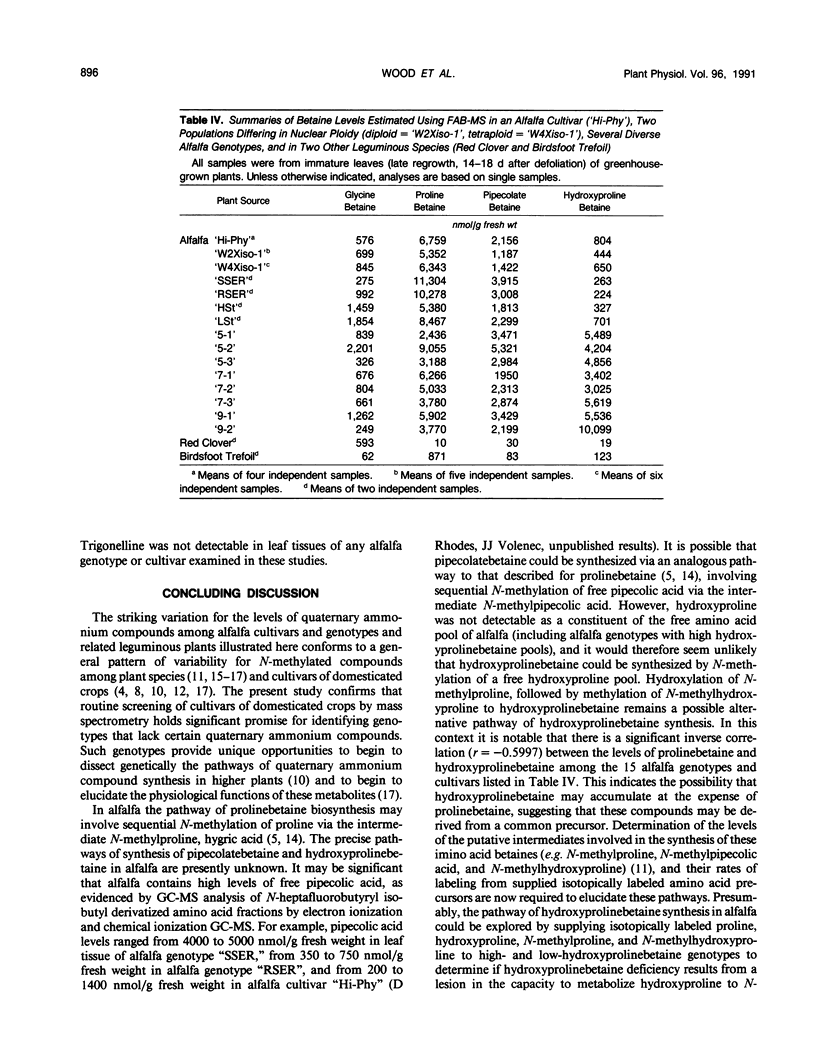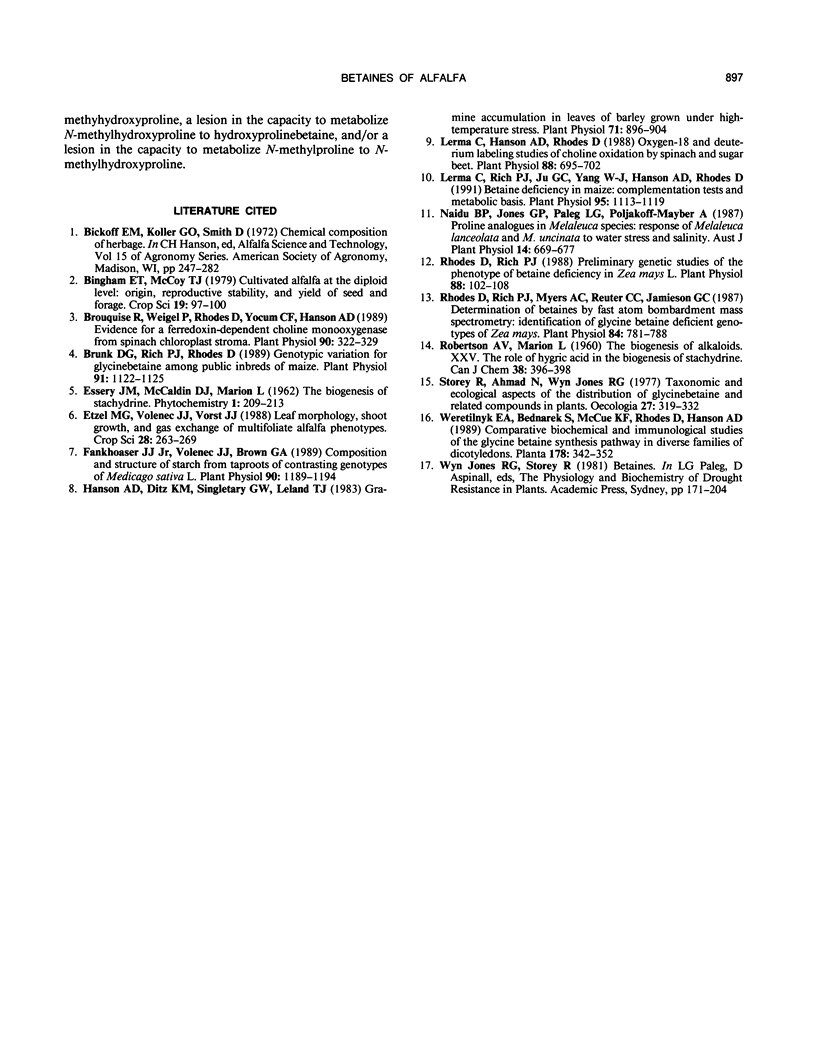Abstract
Leaf tissue of alfalfa (Medicago sativa L.) was found to contain prolinebetaine, pipecolatebetaine, hydroxyprolinebetaine, and glycinebetaine. As n-butyl esters, these chemical species exhibit molecular cations at mass/charge ratio (m/z) 200, 214, 216, and 174, respectively, when analyzed by fast atom bombardment mass spectrometry. The underivatized betaines exhibit protonated molecular ions at m/z 144, 158, 160, and 118, respectively, when analyzed by desorption chemical ionization mass spectrometry. Extensive (>45-fold) genotypic variation for hydroxyprolinebetaine level was identified in alfalfa. Because a significant inverse correlation between prolinebetaine and hydroxyprolinebetaine levels was observed among 15 alfalfa genotypes evaluated, it is possible that these compounds may be derived from a common intermediate. Birdsfoot trefoil (Lotus corniculatus L.) contained prolinebetaine, but only traces of glycinebetaine, pipecolatebetaine, and hydroxyprolinebetaine. Red clover (Trifolium pratense L.) lacked prolinebetaine, pipecolatebetaine, and hydroxyprolinebetaine, but contained appreciable levels of both glycinebetaine and trigonelline. Trigonelline was not detectable in the leaf tissue of any alfalfa genotype or cultivar evaluated.
Full text
PDF





Selected References
These references are in PubMed. This may not be the complete list of references from this article.
- Brouquisse R., Weigel P., Rhodes D., Yocum C. F., Hanson A. D. Evidence for a ferredoxin-dependent choline monooxygenase from spinach chloroplast stroma. Plant Physiol. 1989 May;90(1):322–329. doi: 10.1104/pp.90.1.322. [DOI] [PMC free article] [PubMed] [Google Scholar]
- Brunk D. G., Rich P. J., Rhodes D. Genotypic Variation for Glycinebetaine among Public Inbreds of Maize. Plant Physiol. 1989 Nov;91(3):1122–1125. doi: 10.1104/pp.91.3.1122. [DOI] [PMC free article] [PubMed] [Google Scholar]
- Fankhauser J. J., Volenec J. J., Brown G. A. Composition and Structure of Starch from Taproots of Contrasting Genotypes of Medicago sativa L. Plant Physiol. 1989 Jul;90(3):1189–1194. doi: 10.1104/pp.90.3.1189. [DOI] [PMC free article] [PubMed] [Google Scholar]
- Hanson A. D., Ditz K. M., Singletary G. W., Leland T. J. Gramine Accumulation in Leaves of Barley Grown under High-Temperature Stress. Plant Physiol. 1983 Apr;71(4):896–904. doi: 10.1104/pp.71.4.896. [DOI] [PMC free article] [PubMed] [Google Scholar]
- Lerma C., Hanson A. D., Rhodes D. Oxygen-18 and deuterium labeling studies of choline oxidation by spinach and sugar beet. Plant Physiol. 1988 Nov;88(3):695–702. doi: 10.1104/pp.88.3.695. [DOI] [PMC free article] [PubMed] [Google Scholar]
- Lerma C., Rich P. J., Ju G. C., Yang W. J., Hanson A. D., Rhodes D. Betaine deficiency in maize : complementation tests and metabolic basis. Plant Physiol. 1991 Apr;95(4):1113–1119. doi: 10.1104/pp.95.4.1113. [DOI] [PMC free article] [PubMed] [Google Scholar]
- Rhodes D., Rich P. J., Myers A. C., Reuter C. C., Jamieson G. C. Determination of Betaines by Fast Atom Bombardment Mass Spectrometry : Identification of Glycine Betaine Deficient Genotypes of Zea mays. Plant Physiol. 1987 Jul;84(3):781–788. doi: 10.1104/pp.84.3.781. [DOI] [PMC free article] [PubMed] [Google Scholar]
- Rhodes D., Rich P. J. Preliminary Genetic Studies of the Phenotype of Betaine Deficiency in Zea mays L. Plant Physiol. 1988 Sep;88(1):102–108. doi: 10.1104/pp.88.1.102. [DOI] [PMC free article] [PubMed] [Google Scholar]


